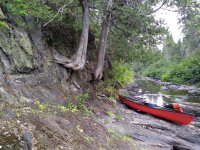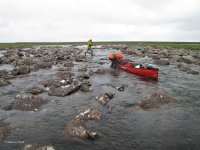- Joined
- Jul 6, 2021
- Messages
- 643
- Reaction score
- 1,174
Blackfly’s Blue Steel scratches got me thinking – and I am sure there are stories – what single trip did the most damage to a canoe you owned?
I expect this will pale in comparison to sundry wrecked and irretrievable pins, but the very first trip in the Mohawk Odyssey was as willfully abusive as anything I’ve ever done.
Our Mohawk Odyssey was an unblemished used RX canoe; the original owner was so proud of the hull’s condition. The very first trip, on section of river with no gauge or useful correlation, after a long complex multi-vehicle shuttle, we arrived at the put in and, in near unison, said “That looks really low”.
The “trip organizer” (not me) replied “I think it gets deeper”. We kinda debated it, but we were there, at the put in, in great weather, with the shuttle set. Whadda ya gonna do, drive home like a wimp?
That would have been a wise choice. It did not get deeper, the tributaries were trickles, and in places that should have had fun waves and rapids there was often barely a hull width to sneak between boulders. Eh, sometimes less than a hull width. There was some inadvertent pinballing, and the rocks and boulders weren’t the worst of it.
The river narrowed at a bridge crossing. A bridge supported by a concrete pylon, set mid-river. A pylon with a massive, rectangular and noticeably crumble decayed foundation, now fully exposed by the low water, smack dab where the only available current piled against it.
The only run-able spot was tight against the pylon. By “tight” I mean I couldn’t I couldn’t get much of a paddle blade in the water to even set up an approach, or effect a draw, and could only cringe as one side of the canoe skreeeeked against the crusty concrete foundation. It was a memorably long concrete foundation; I remember because I hugged most of it trying to keep my head inside the gunwales.
The Odyssey is still going strong, and has the usual 10,000 bottom scratches, but the ones high up on the left chines, I remember where they are from. And I smile.
Hell, the larger dents in our old aluminum canoes each held a memorable story. The history of the giant dent in the bow of our Wards Sea King will forever live in memory.
Let’s hear some tales of canoe abuse, especially if you were – mistakes were made - at fault.
I expect this will pale in comparison to sundry wrecked and irretrievable pins, but the very first trip in the Mohawk Odyssey was as willfully abusive as anything I’ve ever done.
Our Mohawk Odyssey was an unblemished used RX canoe; the original owner was so proud of the hull’s condition. The very first trip, on section of river with no gauge or useful correlation, after a long complex multi-vehicle shuttle, we arrived at the put in and, in near unison, said “That looks really low”.
The “trip organizer” (not me) replied “I think it gets deeper”. We kinda debated it, but we were there, at the put in, in great weather, with the shuttle set. Whadda ya gonna do, drive home like a wimp?
That would have been a wise choice. It did not get deeper, the tributaries were trickles, and in places that should have had fun waves and rapids there was often barely a hull width to sneak between boulders. Eh, sometimes less than a hull width. There was some inadvertent pinballing, and the rocks and boulders weren’t the worst of it.
The river narrowed at a bridge crossing. A bridge supported by a concrete pylon, set mid-river. A pylon with a massive, rectangular and noticeably crumble decayed foundation, now fully exposed by the low water, smack dab where the only available current piled against it.
The only run-able spot was tight against the pylon. By “tight” I mean I couldn’t I couldn’t get much of a paddle blade in the water to even set up an approach, or effect a draw, and could only cringe as one side of the canoe skreeeeked against the crusty concrete foundation. It was a memorably long concrete foundation; I remember because I hugged most of it trying to keep my head inside the gunwales.
The Odyssey is still going strong, and has the usual 10,000 bottom scratches, but the ones high up on the left chines, I remember where they are from. And I smile.
Hell, the larger dents in our old aluminum canoes each held a memorable story. The history of the giant dent in the bow of our Wards Sea King will forever live in memory.
Let’s hear some tales of canoe abuse, especially if you were – mistakes were made - at fault.



